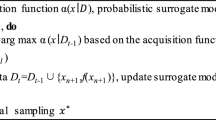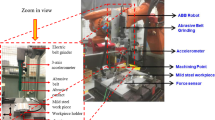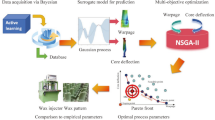Abstract
This study aims to predict the hardness of steel wire rods produced in the actual process by using statistical analysis and machine learning algorithms. The prediction model is built through five steps: operational data collection, key feature selection, experimental data collection, building a prediction model, and revising the model. We propose an innovative data collection methodology that mitigates the challenges posed by the wire rod’s form and resolves the issue of mismatch between different measurement locations. The effects of features on hardness of wire rod are estimated with correlation analysis and explainable AI method. To ensure the model’s robustness across varying process conditions, experimental data are collected via conducting a simulation test on key features that have a large effect. A hardness prediction model using experimental data is validated and revised using operational data. Several statistical indices ensure that the prediction model has good prediction performance. The proposed method has contribution in that it provides a systematic procedure to predict the hardness of wire rods using operational data from the wire rod rolling process. It serves as an effective tool for predicting and optimizing the hardness of steel wire rods.










Similar content being viewed by others
References
Bhardwaj B, Kumar R, Singh PK (2014) Surface roughness (Ra) prediction model for turning of AISI 1019 steel using response surface methodology and Box-Cox transformation. Proc Inst Mech Eng, Part B: J Eng Manuf 228(2):223–232. https://doi.org/10.1177/0954405413499564
Choi YS, Kim SJ, Park IM, Kwon KW, Yoo IS (1997) Boron distribution in a low-alloy steel. Met Mater-Korea 3(2):118–124. https://doi.org/10.1007/BF03026135
Harste K, Wustner E (2004) Innovative solutions for the production of wire rod and bar. Stahl Eisen 124(1):43–48
Hwang JK (2020) Effect of ring configuration on the deviation in cooling rate and mechanical properties of a wire rod during the Stelmor cooling process. J Mater Eng Perform 29(3):1732–1740. https://doi.org/10.1007/s11665-020-04694-0
Hwang JK (2020) Effects of nozzle shape and arrangement on the cooling performance of steel wire rod in the Stelmor cooling process. Appl Therm Eng 164:114461. https://doi.org/10.1016/j.applthermaleng.2019.114461
Hwang R, Jo H, Kim KS, Hwang HJ (2020) Hybrid model of mathematical and neural network formulations for rolling force and temperature prediction in hot rolling processes. IEEE Access 8:153123–153133. https://doi.org/10.1109/ACCESS.2020.3016725
Jahazi M, Egbali B (2000) The influence of hot rolling parameters on the microstructure and mechanical properties of an ultra-high strength steel. J Mater Process Technol 103(2):276–279. https://doi.org/10.1016/S0924-0136(00)00474-X
Jakubowski J, Stanisz P, Bobek S, Nalepa GJ (2021, October) Explainable anomaly detection for hot-rolling industrial process. In: 2021 IEEE 8th International Conference on Data Science and Advanced Analytics (DSAA). pp 1–10. IEEE. https://doi.org/10.1109/DSAA53316.2021.9564228
Jiang X, Jia B, Zhang G, Zhang C, Wang X, Zhang R, Yin H, Qu X, Yong S, Su L, Mi Z, Hu L, Ma H (2020) A strategy combining machine learning and multiscale calculation to predict tensile strength for pearlitic steel wires with industrial data. Scripta Mater 186:272–277. https://doi.org/10.1016/j.scriptamat.2020.03.064
Kazeminezhad A, Taheri AK (2003) The effect of controlled cooling after hot rolling on the mechanical properties of a commercial high carbon steel wire rod. Mater Des 24(6):415–421. https://doi.org/10.1016/S0261-3069(03)00095-5
Kohli A, Poirier DR (2017) Correlation of mechanical properties with diameter and cooling rate of 1080 wire-rod. J Mater Eng Perform 26(12):5871–5876. https://doi.org/10.1007/s11665-017-3079-7
Koymatcik H, Ahlatci H, Sun Y, Turen Y (2018) Effect of carbon content and drawing strain on the fatigue behavior of tire cord filaments. Eng Sci Technol-an Int J-Jestech 21(3):289–296. https://doi.org/10.1016/j.jestch.2018.04.010
Kundu S, Mukhopadhyay A, Chatterjee S, Chandra S (2004) Modelling of microstructure and heat transfer during controlled cooling of low carbon wire rod. ISIJ Int 44(7):1217–1223. https://doi.org/10.2355/isijinternational.44.1217
Lee D, Lee Y (2002) Application of neural-network for improving accuracy of roll-force model in hot-rolling mill. Control Eng Pract 10:4
Li X, Dai Y (2018) Prediction model of hot rolled strip quality based on k-means clustering and neural network. Proceedings - 2018 11th International Symposium on Computational Intelligence and Design, ISCID 2018, 2, 150–153. https://doi.org/10.1109/ISCID.2018.10135
Pattanayak S, Dey S, Chatterjee S, Chowdhury SG, Datta S (2015) Computational intelligence based designing of microalloyed pipeline steel. Comput Mater Sci 104:60–68. https://doi.org/10.1016/j.commatsci.2015.03.029
Pavlina EJ, Van Tyne CJ (2008) Correlation of yield strength and tensile strength with hardness for steels. J Mater Eng Perform 17(6):888–893. https://doi.org/10.1007/s11665-008-9225-5
Prieto M, Tanner P, Andrade C (2016) Multiple linear regression model for the assessment of bond strength in corroded and non-corroded steel bars in structural concrete. Mater Struct/Mater et Constructions 49(11):4749–4763. https://doi.org/10.1617/s11527-016-0822-8
Rastegari H, Kermanpur A, Najafizadeh A (2015) Investigating the effects of short time austenitizing and cooling rate on pearlitic microstructure and mechanical properties of a hot rolled plain eutectoid carbon steel. Mater Des 67:217–223. https://doi.org/10.1016/j.matdes.2014.11.038
Shiraiwa T, Miyazawa Y, Enoki M (2019) Prediction of fatigue strength in steels by linear regression and neural network. Mater Trans 60(2):189–198. https://doi.org/10.2320/matertrans.ME201714
Wei Y, Li Y, Zhu L, Liu Y, Lei X, Wang G, Wu Y, Mi Z, Liu J, Wang H, Gao H (2014) Evading the strength- ductility trade-off dilemma in steel through gradient hierarchical nanotwins. Nat Commun 5:3580. https://doi.org/10.1038/ncomms4580
Xie Q, Suvarna M, Li J, Zhu X, Cai J, Wang X (2021) Online prediction of mechanical properties of hot rolled steel plate using machine learning. Mater Des 197:109201. https://doi.org/10.1016/j.matdes.2020.109201
Xu ZW, Liu XM, Zhang K (2019) Mechanical properties prediction for hot rolled alloy steel using convolutional neural network. IEEE Access 7:47068–47078. https://doi.org/10.1109/ACCESS.2019.2909586
Zhang L, Zou D (2020) Product quality prediction of rolling mill in big data environment. Proceedings - 2020 International Conference on Big Data and Informatization Education, ICBDIE 2020, 34–38. https://doi.org/10.1109/ICBDIE50010.2020.00015
Funding
This work was supported by the Korea Evaluation Institute of Industrial Technology (KEIT) and the Ministry of Trade, Industry, & Energy (MOTIE) of the Republic of Korea (Grant number [RS-2022–00155473]: Development of energy efficiency improvement and quality improvement technology by applying big data in the steel rolling process).
Author information
Authors and Affiliations
Contributions
Conceptualization: Dong-Hee Lee. Methodology: Seok-Kyu Pyo, Dong-Hee Lee, Sung-Jun Hur. Formal analysis and investigation: Seok-Kyu Pyo, Sung-Jun Hur. Writing—original draft preparation: Seok-Kyu Pyo. Writing—review and editing: Dong-Hee Lee. Funding acquisition: Sang-Hyeon Lee, Sung-Jun Lim, Jong-Eun Lee, Hong-Kil Moon. Supervision: Dong-Hee Lee.
Corresponding author
Ethics declarations
Conflict of interest
The authors declare no competing interests.
Additional information
Publisher's Note
Springer Nature remains neutral with regard to jurisdictional claims in published maps and institutional affiliations.
Rights and permissions
Springer Nature or its licensor (e.g. a society or other partner) holds exclusive rights to this article under a publishing agreement with the author(s) or other rightsholder(s); author self-archiving of the accepted manuscript version of this article is solely governed by the terms of such publishing agreement and applicable law.
About this article
Cite this article
Pyo, SK., Lee, DH., Hur, SJ. et al. Prediction of spring steel wire rod hardness based on wire rod rolling process data: a case study. Int J Adv Manuf Technol (2024). https://doi.org/10.1007/s00170-024-13740-3
Received:
Accepted:
Published:
DOI: https://doi.org/10.1007/s00170-024-13740-3




